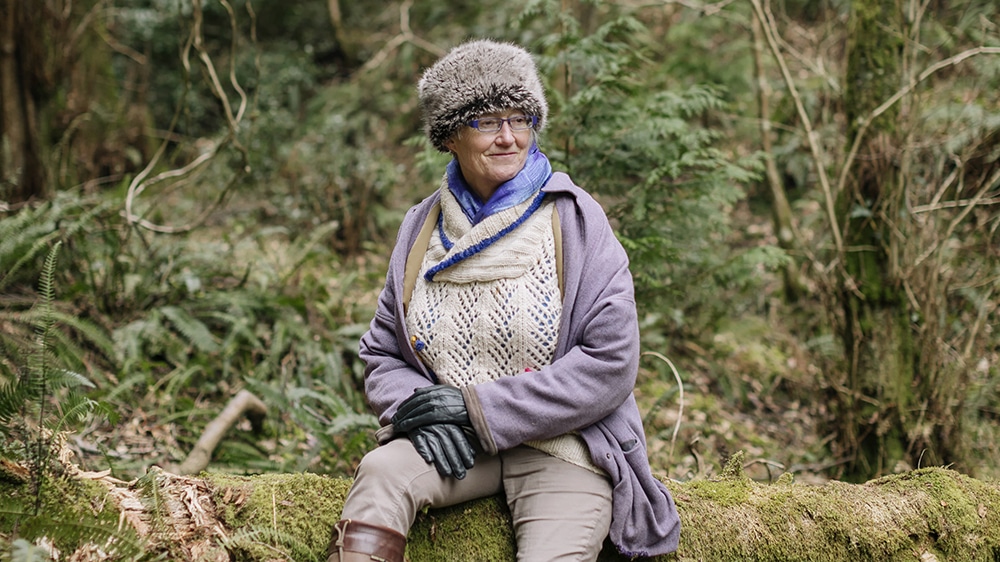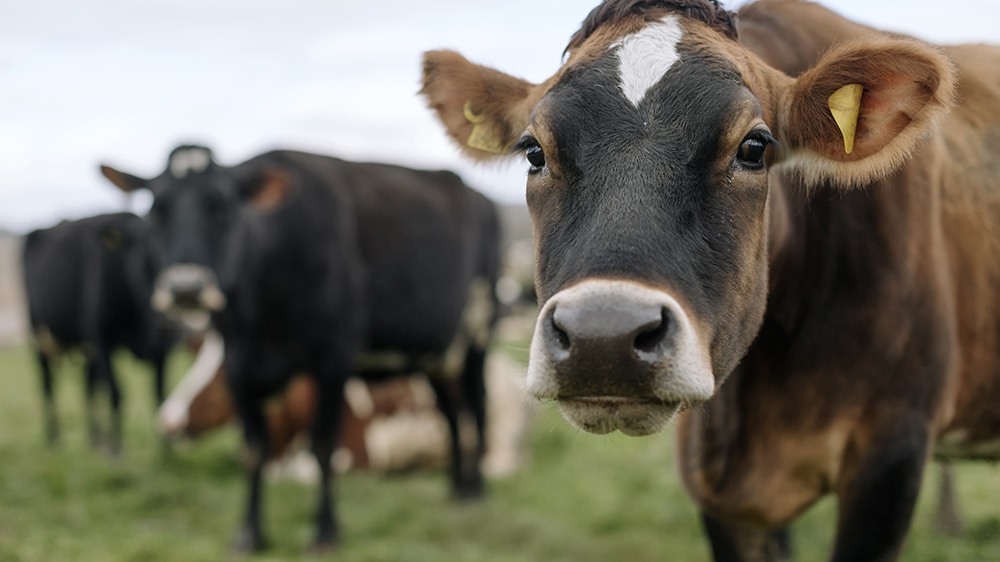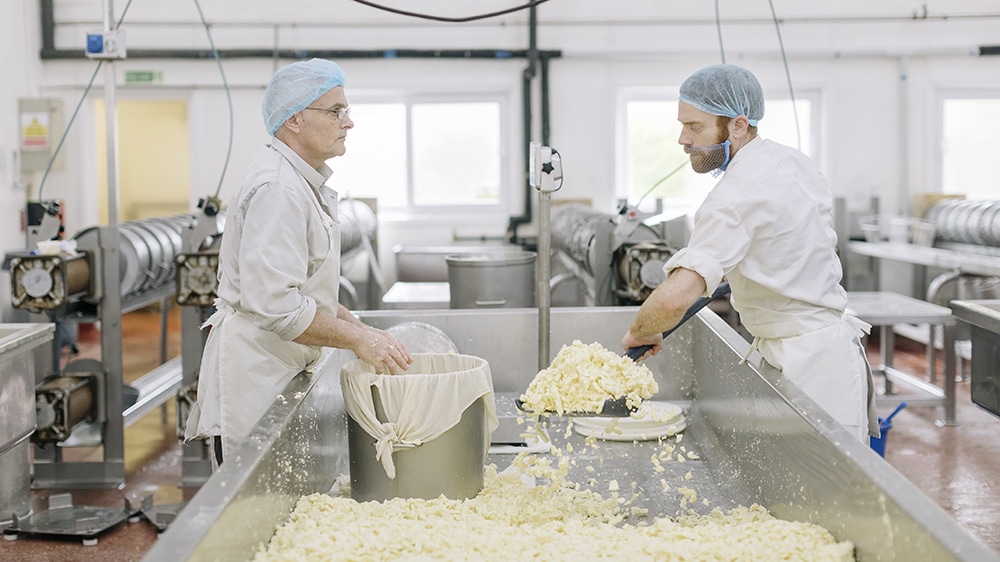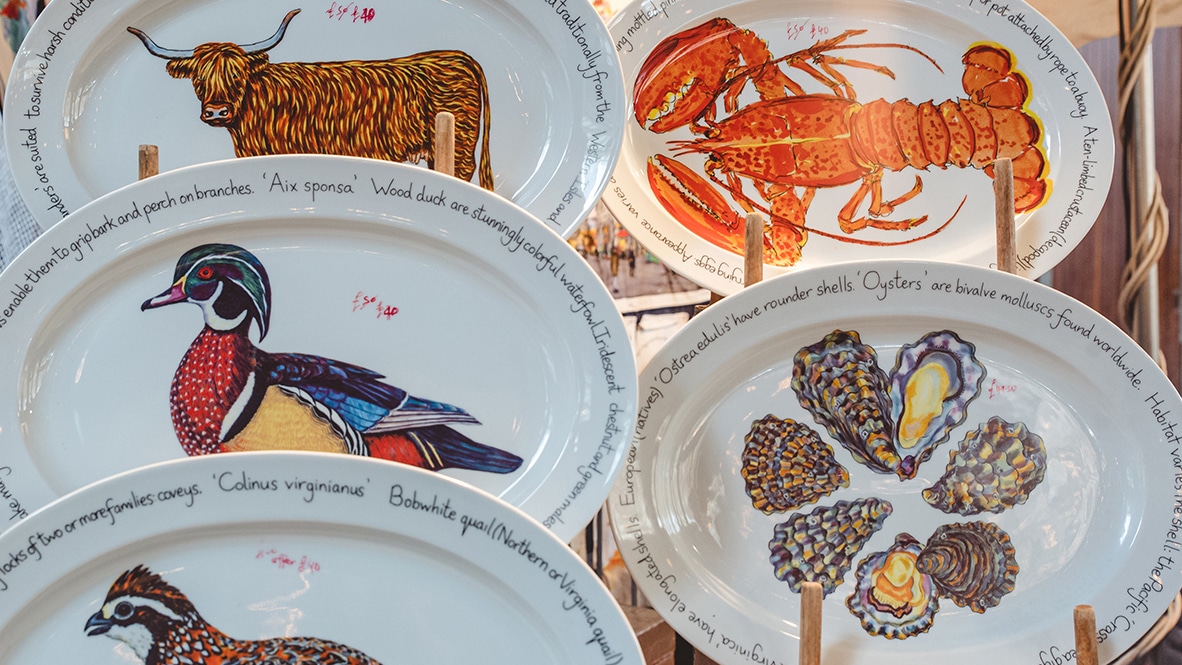Q&A: Mary Quicke
Mary Quicke, owner of Quicke’s and a 14th-generation cheesemaker, on complex cultures, the importance of grazing, and why more women should be running dairies


“WHEN YOU MAKE CHEESE IN A MASSIVE BLOCK, YOU LOSE THE CONNECTION TO THE PLACE IN WHICH IT’S PRODUCED”
Interview: Ellie Costigan / Images: Orlando Gili
There are very few cheesemakers in Britain more thoroughly steeped in the history and culture of their craft than Mary Quicke, the owner of Quicke’s. Her family have been farming the same beautiful stretch of land near Newton St Cyres in Devon since 1540, so dairying is in her blood as well as being something that both fascinates and excites her. Mary’s exceptional cloth-bound cheddar cheeses are sold at Borough Market by Heritage Cheese and Neal’s Yard Dairy.
You’re a 14th-generation cheesemaker. Did you always know you’d take on the family business?
I’ve got three brothers, so I always assumed one of them would take on the farm – that’s the traditional thing. My dad was very off-putting. I think he felt he’d done it by obligation, so he was very keen for us to explore other things. I ended up living in London but whenever I went back to the farm, I was just so inspired. I just wanted to come back – eventually I said, “Dad, please can I!” And he said yes. I’ve been running the business since 1987.
Your family has farmed in Newton St Cyres since the 16th century. The dairy industry must have changed a lot during that time.
In the old days, cheese used to be made in every farmhouse, because that’s how you took milk from the summer to the winter. We’ve got pictures of people making cheese on the farm in the 1920s and 1930s. But all that stopped, along with most farmhouse cheeses, during the war. At that point all milk – other than a few places that made national cheese, which was kind of a young, sub-cheddar – went as liquid to feed the population.
One day, my grandfather was told by the milk buyer of Exeter, “We don’t want your milk today Mr Quicke.” That really struck my father, as a little boy: dairy farming doesn’t work if you don’t sell your products. When he came to run the farm, he wanted to make sure he produced something that people would really want. There is always demand for cheese – it’s up to us to make sure we make it delicious. My mother – who’d been told during art school that her training allowed her to do anything – built the current dairy in 1972, while raising six kids. My parents wanted to make cheese the old-fashioned way.

What makes your traditional farmhouse cheddar different to the mass-produced stuff?
We pasteurise our cheese, but otherwise we are very much still making it the old-fashioned way. The milk is 100 per cent from our own herd; we use heritage starters; we hand-cheddar, which is the process of stacking up the blocks of whey. When it’s made on an industrial scale, you’ve got these things called CheddarMasters, where a huge amount of whey is turned over very slowly in a waterfall-like motion, which produces a different result. Every teeny-weeny thing you do, every decision you make, affects the outcome of the cheese. The mantra of Malcolm, our cheese manager, is: “Do it as it’s meant to be done.” Industrialising is about putting less work into it. When you make cheese in a massive block, you lose something – the connection to the place in which it’s produced, that interaction with the environment.
How intricately linked are the environment and the flavour of the cheese?
Cheese is like wine; it’s a real expression of the terroir. Milk or cheese produced even just 10 miles away will taste different to ours. In our cheese store – our cheese cathedral! – what we’re doing is growing a mould garden. Those moulds make a real difference to the flavour of the cheese. We did a swap with James Montgomery in Somerset – put two of our cheeses in his storage, two of his in ours – just to see what effect it had. The difference was profound. Cheesemakers from other farms come here, we show them what we do, and we absolutely know that they won’t end up with the same results.
Cheese tells the story of the place it’s come from. We love coming to Borough to see people learning about our cheese. What’s fantastic about Borough Market is, every one of those foods has a great story. You can cross the wavy bridge from the heart of the financial centre, where it’s all about business and money, and there in the Market people are thinking about soil, about mould. It’s extraordinary.
The word ‘consumer’ encourages you to be passive – to be on the receiving end of a huge chain, as opposed to choosing on the basis of knowledge, after proper consideration. But if you eat with knowledge, you’re absolutely in the driving seat. You can, as Slow Food says, be a co-producer. Your buying decisions make a difference – you’re funding that place. In so doing, you’re impacting the people there and planet you live on. I think that’s enormously empowering.

Do you think the microclimate you have here is particularly conducive to dairy farming?
Neal’s Yard Dairy described our cheese as “luscious” – it’s a good word for it. We do have this incredibly lush pasture. Our grass grows by itself, and it grows beautifully – incredibly. Among those farmers who measure their grass, it’s famous. We’re situated in a rich, alluvial valley next to the River Creedy – I always wonder if it’s a coincidence that it rhymes with greedy – and some of the swathes have been here since my dad’s time. I’m really pleased about that, because underneath perennial pasture you develop more organic matter, and those deep-rooted plants reach down into the soil and bring up nutrients.
You were at the forefront of a move away from intensive farming methods. What prompted that?
I’ve been on a journey. When I first came into farming, we had these thoroughbred animals that produced lots of milk. But it wasn’t right for our cheese. We thought, what’s missing? Grazing. But our pedigree cows didn’t really like grazing outside, so we crossed them with fresian, Swedish red, montbeliard and a teeny bit of jersey.
The farming method we use now is called extended grazing, which means the cows do all the work: they make their own beds, get their own feed, spread their own manure. It means when we work with the cows, we’re working with the animals, not with a machine. I don’t want to knock other systems, but for us, when we were producing higher yields and the cows weren’t doing as much grazing, the cheese didn’t taste how I wanted it. But it does mean the cows produce a lot less milk. There’s an argument that you should be producing as much milk from each cow as possible, from a carbon footprint perspective, because cows produce methane. But on the other hand, our cows are living longer so a lower percentage of their time is spent rearing and a higher percentage producing milk for the dairy. A grass-fed cow also produces less methane.
After years of crossbreeding and testing, do you feel like you’ve perfected the recipe?
Never! I’ve got this picture in my mind of the flavour I’m after, and I’m forever pursuing it. There’s so much to learn – chemistry, biology, physics. Milk is such a complex thing and it can go down thousands of different pathways, depending on countless factors. You couldn’t possibly know everything there is to know about cheesemaking. The complexity of the soil, breeding, the starters, what’s happening within the cheese when you make it and what’s happening on its rind. It’s glorious. That’s what’s so inspiring – you’re sitting on top of this incredibly complex, beautiful machine that you couldn’t ever possibly fully understand. It blows my mind. Yes, we’re trying to produce milk with a particular flavour, but there’s so much involved in finding the best cheese that’s sitting within it. It’s why we are constantly taste testing – often hundreds of cheeses within a few hours. We taste them at three months, six months, 12 months, to work out how long we should age each one. When is it going to be at its best? It’s a bit like Michelangelo looking at a block of marble: there’s a statue in there, and we’ve got to find it.

Explain what you mean by ‘heritage starters’.
A starter is a complex mix of microorganisms, with lots of bugs that operate in different ways, and each makes a stamp on the cheese. Our starters were collected from the best cheese dairies of the sixties and seventies, by somebody called John Lewis – nothing to do with Waitrose. Most industrial dairies use cultures that have a maximum of three strains of bugs and are much simpler in profile – for example, very sweet or very sharp – so the cheese they produce is the same every day. We use several cultures and because of that, there’s more variability. A winemaker has a vintage once a year; we have a vintage every day.
Our starters were actually almost discarded, at one point. They’d ended up in the hands of a French yeast-making company, who couldn’t make any money out of them, so they went to get rid of them. Fortunately, an amazing man, a microbiologist called Ray, stole them and brought them back to Somerset. To think – all those years of development. Those exquisite, complex flavours. You wouldn’t be able to replicate that. It’d be like destroying history or music or art – it’s no surprise they’re called cultures. They’re integral to the cheese. He rescued them.
Last year you set up the Cheese Academy. What was your intention?
One of the really fun things I get to do is go to America every year to judge cheese. They’re really interested in all the nerdy stuff, and so embarrassed by their dreadful sliced cheese – though they are now making some truly awesome cheeses over there, it’s a real challenge because the great bulk of people in America don’t know the first thing about cheese.
To address that, the American Cheese Society that runs this competition also set up something called the Certified Cheese Professional. Initially I thought, don’t be so Henry James. But then I saw all these young people getting so excited about cheese. Most people who find their way into cheesemongering get a job after school because that’s what’s on offer, and it just captivates them. But their knowledge doesn’t have any status. Getting a certification gave them honour and recognition. Not only that, it gave them confidence. I thought that was just amazing. I was unhappy with the certification we have here – which is only one level, for professionals, and you don’t even do any tasting – so I wanted to bring that to the UK.
The other thing is, while there are an awful lot of cheeses in this country and that’s really exciting, we need to create that pull of people wanting to buy it and sell it and serve it in their restaurants. The plank of Slow Food is, it’s got to be good, clean and fair – part of it being fair is being able to make a sensible living out of creating these amazing products. And you can’t do that if people don’t understand it. Why am I paying that much for cheese, when I can get it for a fiver a kilo in the supermarket? We need to be able to say, here’s why, this is the story, these are the flavours, this is what you’re getting for that money. The impact of the WSET Master of Wine programme in the seventies was crazy – now all sorts of wine has a place in the sun. We want to do that with cheese.
The dairy industry is known these days for being male dominated. Do you think that’s changing?
Certainly, in terms of cheddar-makers, I think I am the only woman leading a business. It wasn’t always that way. In all the old cheesemaking books, the cheesemaker is always a ‘she’. They were dairy maids. A lot of the traditional cheesemaking recipes fit in around child-rearing. Mechanisation really changed the field of dairy. Once it went outside the home and you had a machine to do things, suddenly men were interested! The irony is, mechanisation makes things easier for women: the standard weight you’d need to be able to carry 100 years ago was around 100 kilos, which is seriously heavy. Even when I started working it was about 50 kilos. Now nobody lifts anything. We’re not limited by the fact that women, in general, are a little less physically strong than men. While there are lots more women coming into farming, there’s still the sense that it’s a masculine thing to do. But really, it’s about knowledge and being thoughtful with it – which absolutely isn’t more suited to either gender.


